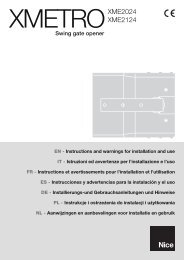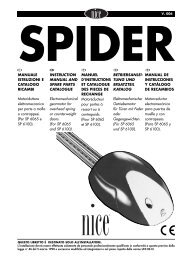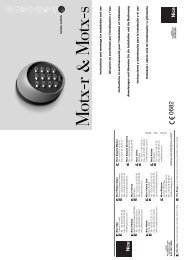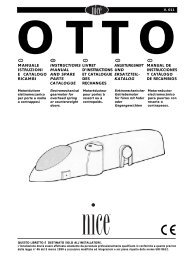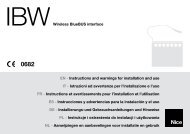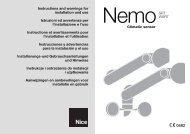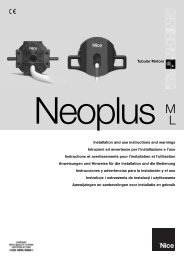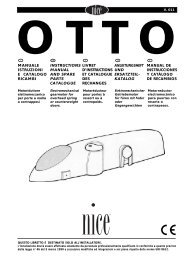F - Nice-service.com
F - Nice-service.com
F - Nice-service.com
- No tags were found...
Create successful ePaper yourself
Turn your PDF publications into a flip-book with our unique Google optimized e-Paper software.
3.3.13) 13 REMOVE PASSWORD [ C ]This function serves to remove the password for access to data contained in the memory plugged into connector [7].This function is the opposite of the INSERT PASSWORD function.GB3.3.14) 14 FUNCTION Ch1 [ C ]This function allows you to modify, on the memory plugged into connector [7], the parameter that controls the operatingmode associated with decoder output channel 1. The operating mode can be selected from among the following:“Momentary”; “Timer”; “Bistable” or “Anti-theft”. If the "Timer" mode is selected, the relative time can be editedby means of function 16 CHANGE t TIMER 1. “Anti-theft” mode concerns both the output channels so that when itis activated on one output also the other will automatically switch to "Anti-theft" mode.3.3.15) 15 FUNCTION Ch2 [ C ]This function is similar to the function of output no. 1 described in chapter 3.3.14., although in this case it is relativeto output no. 23.3.16) 16 CHANGE t TIMER 1 [ C ]This function serves to change the time interval of the timer associated with output no. 1 when memory [7] is to beused in a decoder with the timer function active. After confirming the function the message "Time:" will be displayedfollowed by the current timer value; the time is displayed in the format “h” hours, “mm” minutes (tens and units) “ss”seconds (tens and units). The maximum time that the decoder can administrate is 1 hour 48 minutes, 22 seconds.3.3.17) 17 CHANGE t TIMER 2 [ C ]This function is similar to that of timer 1 described in chapter 3.3.16., although in this case it is relative to the timerassociated with output no. 23.3.18) 18 OPERATIONS COUNT [ C ]Allows you to change the operations counter associated with a given Card present in memory [7]. If the counter isnot unlimited (value: ###) each time the Card is used the decoder will deduct one operation; when there are no moreoperations left the Card will be no longer valid until the counter is reloaded.To change the value first select the code concerned using the Cards proximity reading facility (see table 6) or typingthe code directly on keypad [9]; at this point the counter can be modified with any value from “000” to “999”, alternatively,by pressing the “ ” key the counter is set to “###”, i.e. with no restriction on the number of operations.3.3.19) 19 TYPE OF CARD [ C ]This function allows you to change, in memory [7], the parameter relative to the Card type that the decoder is ableto recognise. The Card type can be selected from among the following: “All” (both Card types will be valid); “Blue”(only Blue cards are valid) or “Grey” (only Grey cards are valid).A careful check should be carried out before changing this parameter to avoid the risk of inadvertently deactivatingCards that are already present.3.3.20) 20 CHANGE CARD CODE [ C ]Allows you to change the code present in the "Grey" Cards, replacing it with any other value. The new value must beentered directly from keypad [9]; at this point press “ Ente” and finally bring the "Grey" Card up to the Card codeproximity reader (see table 6); the code will be changed in a matter of seconds.This function is not available for "Blue" Cards.3.4) MOU functions in “Mot” mode [ ] TThis chapter contains an analysis of the functions of the MOU programming unit in “Mot” mode15



